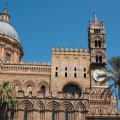One of the most beautiful jewels of Sicily for its majestic medieval Arab-Norman architecture whose interior is austere
It is one of the most beautiful jewels of Sicily, a UNESCO World Heritage Site for its majestic medieval Arab-Norman architecture. This magnificent building, with its rosy colours, is closely linked to the history of Palermo and the island, since it was here that the kings of Sicily were crowned and it is also here that they are buried. Since its construction in the 12th century on the site of an ancient basilica converted into a mosque, the cathedral of Norman origin has undergone numerous restructurings, particularly in the 14th, 15th and 18th centuries, giving it its composite style. Two openwork corner towers with geminated bays flank its richly decorated façade, which dates back to the 14th and 15th centuries. It was also at this time that the bell towers of the four stair towers were built and the major portal on the south side and the sacristy were added. Between 1781 and 1801, part of the façades and the interior of the cathedral were completely overturned and rebuilt by the engineer Ferdinandi Fuga, who, following the neoclassical canons of the time and to the detriment of the architectural homogeneity of the building, erected a dome that is still far from unanimous today. From its Arab past (it was built over an old mosque), it preserves, engraved on one of its columns, verses from the Koran. From the garden, one can access the interior of the cathedral through a superb 15th century carved wooden door. Divided into three naves, this interior is rather austere, despite the sculptures of Laurana (superb Virgin and Child of 1469) and Gagini which decorate it. The relics of St. Rosalia, Palermo's most venerated protector, are also enclosed in a precious silver urn from 1631, in the Chapel of Santa Rosalia, to the right of the choir.
Smart info: the entrance to the church is free, access to the crypt, the treasury, the royal tombs and the rooftops is not free, but it is well worth the visit. Be prepared to elbow your way through groups of tourists, and allow time to visit everything.
The royal tombs. In the chapels to the left of the south entrance are the royal sarcophagi, made of marble and surmounted by canopies in the style of Roman and Oriental funerary monuments. Here are buried Constance of Aragon, wife of Frederick I, Henry VI, Frederick II, Roger II..
The treasure room and the crypt. The entrance is to the right of the Santa Rosalia Chapel. The Treasure Room contains sacred decorations from the 16th and 17th centuries, precious illuminated codes, Byzantine enamels and numerous goldsmiths' pieces, including the important gold and precious stone tiara of Constance of Aragon. To the left of the treasure room there is a small staircase leading to the crypt, whose cross vaults rest on granite columns. Roman, Byzantine and Norman sarcophagi from various periods remain in its thick stone walls. In particular, you will be able to observe the medieval carved sarcophagus of Gautier Ophamil, Archbishop of Palermo from 1168 to 1190, who had the cathedral built in the 12th century.
The roofs of the cathedral. After visiting the royal tombs, climb the steps of a spiral stone staircase. You can then climb up to the roofs of the cathedral where a breathtaking view awaits you. This visit is highly recommended!
Did you know? This review was written by our professional authors.
Book the Best Activities with Get Your Guide
Members' reviews on CATTEDRALE DI PALERMO
The ratings and reviews below reflect the subjective opinions of members and not the opinion of The Little Witty.

